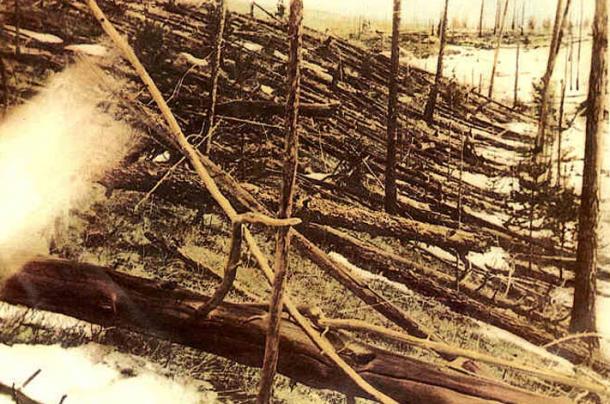
Posted on 07/01/2021 11:16:41 AM PDT by Red Badger
Asteroid Day this year, June 30, 2021, is 113 years after the Tunguska impact event in Siberia, which destroyed an area of pristine forest the size of Tokyo. With blasted and burnt tree trunks leveled and stripped bare over such a vast area, it is as though a large atomic bomb had been dropped on the forest.
The debate still goes on in the research literature, but a popular theory is that this impact was caused by a small comet fragment, in the region of 328 feet (100 meters) in diameter, that exploded at an altitude of around 5 miles (8 kilometers). Its immense downward momentum caused the resulting fireball to target the forest below, like a great blast of dragon breath. No crater was formed, and due to its remote location, it’s thought nobody was actually killed.

Tunguska meteoroid impact, a fraction of the Younger Dryas event. Trees were knocked down and burned over hundreds of square kilometres. (Vizu / Public Domain )
The date of the impact and its apparent direction of travel suggest it was likely caused by a chunk of comet originating from the Taurid meteor stream, the largest meteor stream seen from Earth. The impact energy has been inferred from seismic records at the time of the explosive event as well as computer simulations of the air burst and resulting damage on the ground. At around 5 to 15 megatons of TNT, the magnitude of the Tunguska explosion is often compared to 1000 Hiroshima bombs.
\ Collision with a larger comet, say 0.6 miles (1 kilometer) in diameter, would have generated an explosion around 1000 times larger again, i.e. 1 million Hiroshima bombs. It’s hard to imagine the scale of such an event, but this is the kind of energy scale that has been proposed for the Younger Dryas impact event.
A new paper by Dr. Martin Sweatman of the University of Edinburgh's School of Engineering has just been published in the journal Earth-Science Reviews . It reviews the impact evidence for the Younger Dryas event and covers several of the topics discussed below in more detail.
Ancient Fears to Keep You Up at Night - The End Really, Really is Nigh Planet X – Is there Scientific Evidence? Myths and Meteors: How Ancient Cultures Explained Comets and Other Chunks of Rock Falling From the Sky
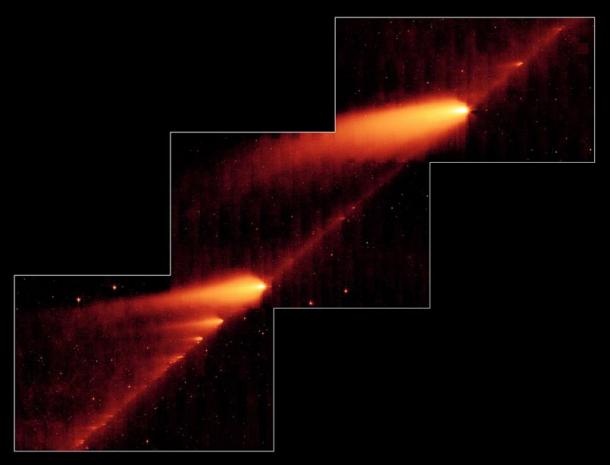
This infrared image from NASA's Spitzer Space Telescope shows the broken Comet 73P/Schwassman-Wachmann 3 skimming along a trail of debris left during its multiple trips around the sun. The flame-like objects are the comet's fragments and their tails, while the dusty comet trail is the line bridging the fragments. (Vesta~commonswiki / Public Domain )
When Did the Younger Dryas Event Occur? The Younger Dryas impact is thought to have occurred between 10,800 to 10,900 BC. Again, it might have been caused by the Taurid meteor stream , although this time the general view is that we collided with a swarm of comet debris, rather than a single object. The impact was so devastating and covered such a wide area, that it is thought to be responsible for an entire geological age (a mini ice-age lasting 1,300 years) known as the Younger Dryas period when temperatures in the northern hemisphere were 27 degrees Fahrenheit (15 degrees Celsius) lower than they are today.
The event caused the extinction of many large animals, especially in the Americas, such as the mastodon and sabre-tooth tiger. Quite possibly, many of today’s well-known myths and religions, including Ragnarok and Christianity, derive originally from a comet-cult inspired by this event. It could hardly be a more important topic.
The Debate on Younger Dryas The research debate surrounding this impact event has been very contentious. Supporters of pre-existing theories for the demise of the American megafauna and the occurrence of the Younger Dryas mini ice age have, naturally, been highly critical of this recent interloper into their long-standing stalemate.
But ultimately, it is not evidence of large animal extinctions or rapid climate change that determine whether a cosmic impact event occurred at this time, as these effects are not diagnostic for such events. That is, these effects can also be generated by other mechanisms. To discover whether a cosmic impact occurred at the beginning of the Younger Dryas period, or the YD ‘boundary’ as it is known, we should instead consider the geochemical evidence, which consists of unusual chemicals or materials generated by the impact remaining in the ground, as this is diagnostic.
Normally, a large asteroidal impact will leave a crater, even if the impact occurs into an ocean – the crater will be in the sea bed in this case. No crater has yet been confirmed for the YD event, although one, and perhaps two, geologically young but very large impact craters under the Greenland ice sheet, discovered only in the last few years, appear to be good candidates.
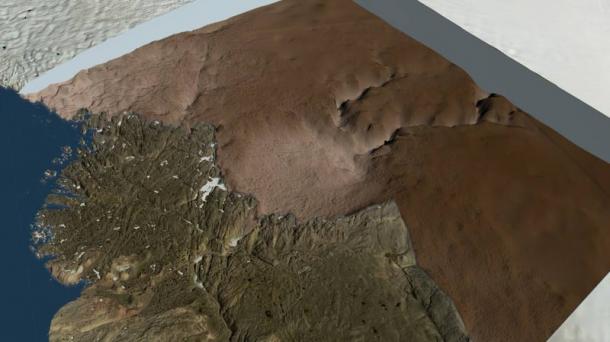
An image from NASA showing the ice sheet removed in the region around the Hiawatha Glacier and the bed topography under the ice clearly showing the Hiawatha crater. (Prokaryotes / Public Domain )
Nevertheless, because the ages of these craters are not yet established, we should instead consider the kind of geochemical signals left behind by Tunguska-like air-bursts at the YD boundary. In fact, many types of exotic material, potentially of impact origin, have been found at this boundary, which appears as a conspicuous band of discolored sediment, or ‘black mat’, at many sites across North America and beyond. Arguably, the three most convincing types of evidence are an abundance of iridium-enriched magnetic grains, nanodiamonds, and high levels of platinum group metals, such as platinum itself or iridium, at the base of the YD black mat.
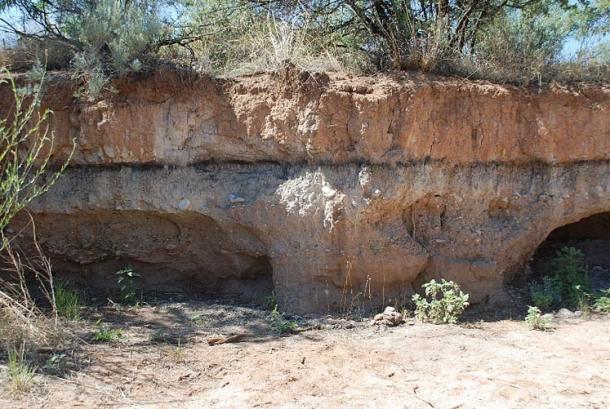
The Younger Dryas boundary lies at the base of the YD black mat. (Comet Research Group / Author Provided)
Magnetic grains, often too small to see with the naked eye, can be formed from iron, common in asteroids and comets, vaporizing at very high temperature, in a massive explosion for example, and then condensing into microscopic magnetic iron droplets, like water condensing as rain. If formed within a cometary air-bust they would be flung through the atmosphere for great distances, creating a carpet or layer of fine magnetic grains over a large expanse of Earth’s surface. Therefore, a sudden large peak, or abundance, in a layer of sediment of iridium-enriched magnetic grains is a good indicator of a cosmic impact, since other sources should be relatively constant over time.
Likewise, nanodiamonds are thought to form within carbon-rich droplets condensing from vaporized carbon generated by a high-temperature and pressure explosion. Asteroids and comets can be rich in carbon, and a cosmic impact might create the conditions required for the formation of carbon droplets containing nanodiamonds. Alternatively, nanodiamonds are common within some asteroids and comets, which means an impact event would simply distribute them over a large patch of Earth’s surface. Therefore, a sudden large peak in nanodiamonds within sediments also very likely indicates a comet or asteroid strike.
The Comet that Sparked a Worldwide Flood ‘Myth’ Did a Comet Destroy Ancient Sardinia? Prehistory Decoded at Gobekli Tepe: From a Cataclysmic Event Dawns the Origin and Perhaps the End of Civilization
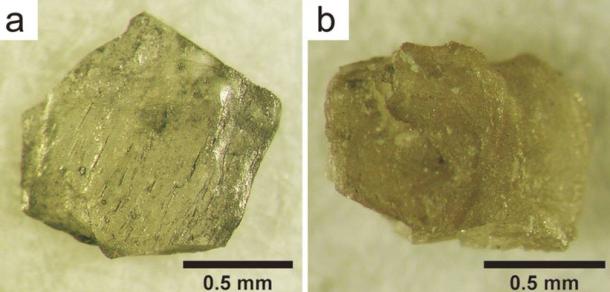
Nanodiamond aggregates from the Popigai crater, Siberia, Russia. a) is composed purely of diamond. b) is composed of a mixture of diamond and small amount of lonsdaleite. (Materialscientist / CC BY-SA 4.0 )
Lastly, platinum group metals (like platinum and iridium) are rare in Earth’s crust, but not so rare in asteroids and comets. Therefore, an abundance, or spike, of a platinum group metal within a sediment layer is another very good indicator of a cosmic impact event. This indicator can be spread very widely around the globe carried within fine dust particles created by the impact explosion.
There is really no alternative mechanism for producing a platinum group metal enriched layer of dust over a large patch of Earth’s surface, other than via a cosmic event like a comet impact, especially if it coincides with an abundance of nanodiamonds and magnetic grains. Indeed, an iridium abundance at the dinosaur-ending 66 million year-old Cretaceous-Palaeogene boundary helped to close that debate out.
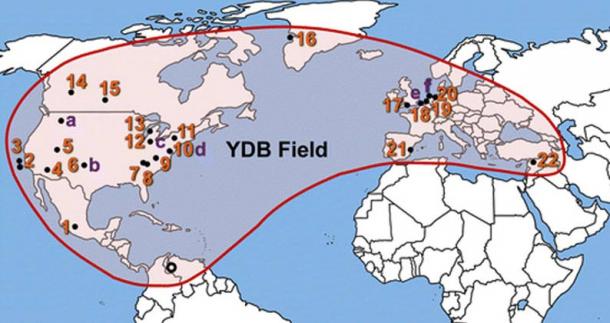
The Younger Dryas boundary (YDB) nanodiamond field. (Comet Research Group / Author Provided)
Each of these lines of geochemical evidence has been found at the YD boundary by the Comet Research Group and later confirmed by several independent research groups. Independent verification of the evidence, by research groups unconnected with the Comet Research Group, is crucial. It means the evidence is real and not mistaken. If other researchers could not find these signals, and there were some negative reports initially, they must have been doing something wrong.
This boundary layer of strange chemicals, which was most likely produced by a swarm of comet debris, has been found spanning three continents. According to the latest research, the debris field now extends to the tip of South America, and to the Near East where we find the world’s earliest megalithic monument – Gobekli Tepe in southern Turkey. Incredibly, the Younger Dryas impact seems to have been recorded there via an early form of proto-writing on its giant stone pillars, and probably inspired its construction.
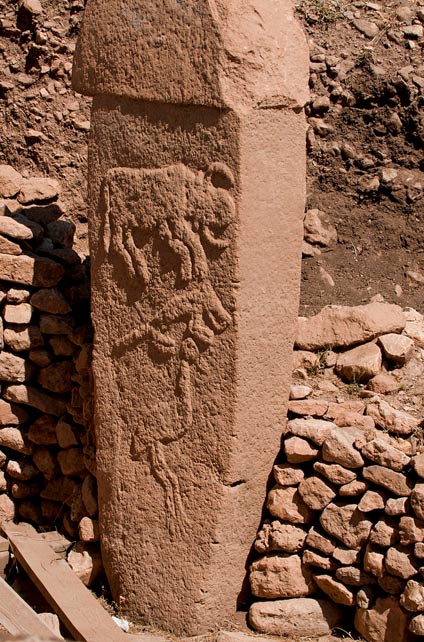
Pillar 2 at Gobekli Tepe, likely describing the path of the radiant of Taurid meteor stream circa 10,000 BC. (Teomancimit / CC BY-SA 3.0 )
One of the clearest geochemical signals of the impact is recorded in a Greenland ice core, which displays a substantial platinum anomaly precisely at the beginning of the Younger Dryas cold period (corresponding to when the oxygen isotope trace, a proxy for temperature plummets). This suggests that this mini ice-age was, very likely, triggered by a cosmic impact. The ice-core date of 12,890 cal BP for this event translates to a calibrated date of around 10,870 BC in real terms.
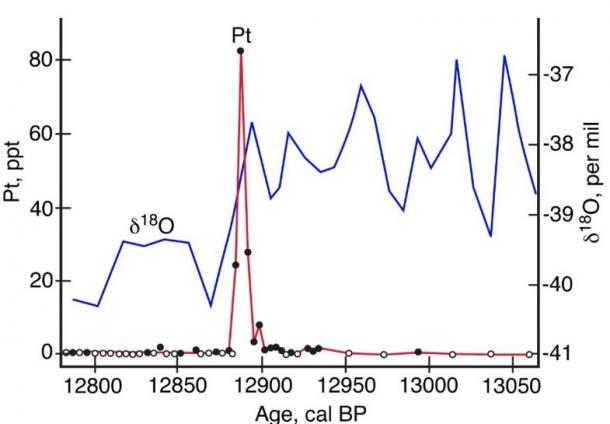
Platinum anomaly (red, left axis) and oxygen isotope trace (blue, right axis) in the GISP2 Greenland ice core. (PNAS / Author Provided)
Despite all the evidence in its favor, the Younger Dryas impact theory has been attacked many times by other researchers desperate to see it repudiated. Initial attempts at refuting it focused on the difficulty of reproducing the geochemical data. But, as has been said, these signals found across several continents have now been confirmed by multiple independent research groups. After this clarification, its opponents accepted the geochemical signals existed, but instead disputed their coincident timing. If they are correct, it implies there could not have been a single, huge, continental-scale Younger Dryas impact event.
However, these attempts to debunk the YD impact theory are all fundamentally flawed, as they make the same basic mistake. Essentially, they fail to properly take the experimental uncertainty in the radiocarbon measurements for these different archaeological sites into account. So, the problem these researchers identify is purely one of their own invention.
Indeed, in 2015, perhaps prompted by this radiocarbon dating controversy , a proper statistical analysis of Younger Dryas sediments was published, from which a date for the event of 10,835 BC, to within 50 years at the level of 95% confidence, was established. This means the geochemical evidence is consistent with a single event, most likely between 10,785 and 10,885 BC, in excellent agreement with the platinum spike in the Greenland ice core.
Is the Younger Dryas Dispute Settled? This appears to have settled the matter. There have been no further reports since 2015 that dispute the Younger Dryas impact theory on the basis of new evidence for these specific lines of geochemical signal. Meanwhile, evidence in its favor continues to accumulate.
For example, similar geochemical signals have been found among the twisted and extensive remains of megafauna frozen into Alaskan and Yukon permafrost, and it has been estimated that around 10% of the world’s land surface was set ablaze by the impact. It is easy to imagine that wildfires as extensive as this, and the choking soot that would have resulted, could have blocked sunlight for many years, killing animals and destroying the plants they feed on.
Traditionally, the sudden occurrence of the Younger Dryas ice age is blamed on a switch in massive oceanic circulation currents that transport vast amounts of heat around the globe. In turn, this oceanic switch is blamed on huge flows of cold and salt-free meltwater running off northern ice-sheets. But recent climate simulations suggest that, by themselves, these effects cannot account for the suddenness and magnitude of the Younger Dryas cooling, and a degree of atmospheric dusting is needed.
A cosmic impact, therefore, seems to be able to provide the conditions needed for both the megafaunal extinctions and sudden climate change at this time. Perhaps it was the trigger for all these effects.
So, What Does Younger Dryas Mean For Us? How does this affect us today? Is it relevant to our lives?
Absolutely. An impact on the scale of the Younger Dryas event is often ruled out by some scientists as being too large to have occurred so recently. There are simply not enough asteroids of the required size currently in near-Earth space, they say, to make this scenario plausible. While this view is reassuring, it is almost certainly wrong.
It is wrong because it fails to take account of how quickly near-Earth space can change. We now know that giant comets from the outer reaches of the solar system can become trapped within the inner solar system, near Earth, on a reasonably regular basis, and this likely occurred relatively recently, say within the last 50,000 years. And, giant comets can appear, fragment into millions of pieces, and decay to dust quite quickly, meaning that today’s skies are no basis for judging the impact risk a few 10s of thousands of years ago, or a few thousand years into our future. Instead, constant vigilance is required.
The paper ‘The Younger Dryas impact hypothesis: Review of the impact evidence’ is published in the journal Earth-Science Reviews .
Martin Sweatman’s book Prehistory Decoded is available from Amazon and Wordery.
Visit his blog here.
Top image: Asteroid Day is June 30th. Source: Lassedesignen / Adobe Stock
By Martin Sweatman
Updated on June 30, 2021.
VIDEO AT LINK...........................
PinGGGY!.......................
Great read thanks maybe the 4th will have an epic finale
Cool stuff.
An impact like that would melt the glaciers really, really fast. And it would have literally scraped the face of the earth down to bedrock. If it hit in North America, this would explain the erosion in the south west.
And it explains “The Flood.” Doesn’t change the biblical narrative at all.
Imaginative fellow.
“Pillar 2: The second central pillar of Enclosure A, likely depicts the sequence of constellations, Capricornus (bull), Aquarius (fox) and Pisces (tall bending bird), which would likely have been the path of the radiant of the northern Taurid meteor stream circa 10,000 BC. Possibly, this pillar represents the name of that meteor stream.
“We know the Taurids exhibit longitudinal precession of roughly 30 degrees every 6,000 years, which equates to about 4 hours along the ecliptic from today’s radiant path if translating to 10,000 BC). This means the current path of the Northern Taurids shown in Stellarium (mid-Pisces through Aries to the end of Taurus) would translate to mid-Capricornus through northern Aquarius to end-Pisces, as shown on Pillar 2. The fox, though, is facing the wrong way, so I have reversed Aquarius in the image below.
“Similarities with the Cartouche writing convention of AE is clear - see an example in the middle below. See also a stone plaquette (below right) found at GT, which has a similar structure. Possibly, this stone plaquette tells the story of the comet god (trident symbol) who attacked and killed (explosion symbol) the cosmic serpent god (falling snake symbol) who fell to Earth, perhaps a mythical description of the Younger Dryas event. It is a myth, the ‘chaoskampf’, repeated in many religions, including by the Ancient Egyptians (Set vs Apep), Babylonians (Marduk vs Tiamat), and Christians (the fall of Satan). The site’s archaeologists interpret this stone plaquette simply as the sequence (the other way up), snake, tree, bird, with no further meaning.
“The bull symbol at the top of Pillar 2, likely representing the constellation Capricornus, is probably connected to many ancient cow deities and entities, including those of Ancient Egypt (e.g. Hathor and Apis) and the Babylonian Bull of Heaven, and even the Pictish Burghead Bull symbols. Typically, the bull is associated with death, an association that might date back to the the Lascaux Shaft Scene and a time when the Taurid meteor stream was probably centred on Capricornus.”
https://martinsweatman.blogspot.com/2020/10/gobekli-tepes-pillars.html
It would explain the Grand Canyon...................
No, only the Noachic flood explains the grand canyon, the state of florida, the immense sand deposit in the gulf of mexico, etc. The great flood is no myth, it is geologic fact that we see every day.
Something like trillions and trillions of gallons of water carved out the Grand Canyon, and very quickly.
A a flood of melting ice sheet from a comet impact would fit the bill...............

Depends on the direction and angle the comet hit and the wind patterns.........................
Hence the ferocity of the Science dogma about any YD event discusssion. Not permissible since the implications are not permissible.
In ancient cultures, the bird symbol usually represents the Swan, not Pisces. The Swan was the representation of birth, life, and death to the ancients prior to the Event and afterward.
Examples of the Events ferocity can be seen in the Carolina Bays and the Nebraska Rainwater Basin this were likely created by thrown off impact debris which in this case would be huge sheets of Ice from the Glacial impact - while the Author cites Greenland as a possible impact site, there exists good evidence that not only were there multiple impacts by 1 mile diameter rocks, but that tracing the possible impact trajectory back to somewhere in the Great Lakes-Northern Michigan area. Numerous authors believe that the strikes lasted about 100 years, turning plants, animals, people into slices from the ice shards impacting the earth and shattering, while other strikes caused fires - not just forest fires, but firestorms lasting decades.
One notable fact is that before the strikes, North Africa was a lush forested land; but after it became dry, hot and harsh. Many people were forced to move west to the Nile valley. This was a real climate change, not the pseudo-scientific one claimed by leftards today.
I always thought that it was too “sharp” to have been eroded over millions of years. But that isn’t a scientific theory…HA HA.
The “flood mythology” is not unique to the Bible. I’m not sure why people (on either side) get worked up over that.
are there not prevailing westerlies? i am confused...

No not the Grand Canyon that is attributable to other things. The rest has some validity - there certainly were floods as sea level rose on average 450 feet worldwide, and in some places 750 feet, covering millions of square miles of once prime habitable land and river mouths.
I’m no geologist, but I play one on FR......................
Washington state scablandss too. https://www.pbs.org/wgbh/nova/megaflood/about.html
TV Program Description
Original PBS Broadcast Date: September 20, 2005
Mystery of the Megaflood homepage
One of the Earth’s strangest geological riddles is the evidence for a huge catastrophe that struck eastern Washington State thousands of years ago. It took scientists decades to figure out that a colossal flood had carved out bizarre landscape features strewn across thousands of square miles. On “Mystery of the Megaflood,” NOVA gets to the bottom of what created this compelling detective story.
“Mystery of the Megaflood” features a dogged geologist sticking to his bold theory for decades despite virtual professional banishment. Eventually, other geologists joined his cause and filled in the intricate details, which NOVA recreates in stunning computer animation to show what may be one of the most spectacular series of events ever to occur on our planet.
The so-called “scablands” are a vast region of weird terrain 200 miles east of Seattle, including gorges hundreds of feet deep, enormous pits, huge boulders scattered as if dropped by giants, undulating hills that look like huge ripples, strange layers of silt and ash, and a “waterfall” five times wider than Niagara, but without any water (see Explore the Scablands). The name “scablands” perfectly suits the scarred and wounded landscape, which baffled most geologists throughout the 19th century and much of the 20th. To them, no plausible explanation fit all the facts.
For example, there is no large river cutting through the scablands that could have carved the features over millions of years—as the Colorado River did in the Grand Canyon. Nor is there evidence that the area was buried beneath glaciers that produced extensive erosion—as occurred in large sections of the American and Canadian Rockies.
But during the 1920s a geologist named J Harlen Bretz outlined a startling hypothesis. His fieldwork convinced him that the scablands were not the result of slow geological weathering, but of an enormous catastrophe that had taken place almost overnight when a titanic flood engulfed the region. Many of his colleagues ridiculed the idea, especially because it smacked of “catastrophism,” a discredited view that Earth had been shaped by sudden cataclysms rather than by slow evolutionary change.
Bretz was unable to say where all the water had come from, but a colleague named Joseph Thomas Pardee was certain that the answer lay in the region around Missoula, Montana, where the surrounding mountains held evidence that an enormous lake had once filled the basin (see Ice Age Lake). This lake formed when a glacier plugged the valley below Missoula during the last ice age, creating a natural dam and eventually a body of water that was half the size of Lake Michigan. If that dam suddenly burst, the path of the released water would rush directly over the scablands, scouring exactly the kinds of features that are observed there today.
All that was needed was a natural mechanism to breach the dam and release Lake Missoula—no easy feat since the glacier was probably thousands of feet thick. Such a mechanism was finally discovered after a much smaller glacial dam burst in Iceland in 1996, causing incredible devastation in the valley below.
NOVA takes viewers on a virtual tour inside a glacier to see how tremendous pressure creates tunnels of supercooled water that, over time, fatally weaken the structure of an ice dam, causing it to fail. The current plot twist to the scablands story is that a deluge happened not once, but repeatedly, as ice dams reformed and the glacial lake refilled, only to empty again and again onto the scarred terrain of what is now eastern Washington
Why are the impact and cold oceans theories incompatible?
(Or am I just not a libtard, back-stabbing academic stuck in an intellectual dungeon of my own creation?)
Disclaimer: Opinions posted on Free Republic are those of the individual posters and do not necessarily represent the opinion of Free Republic or its management. All materials posted herein are protected by copyright law and the exemption for fair use of copyrighted works.